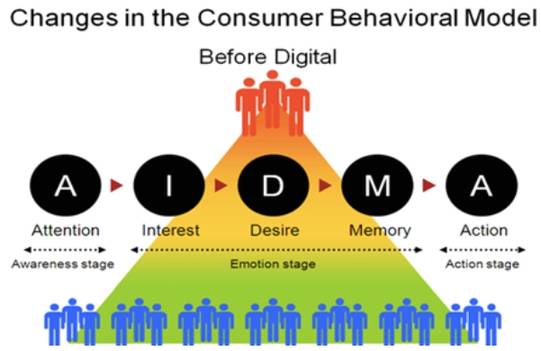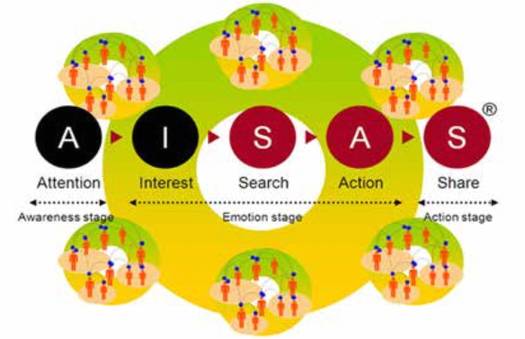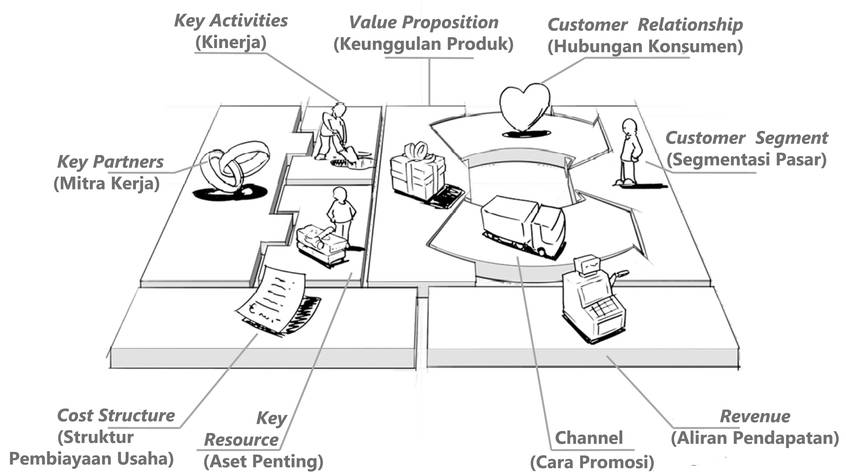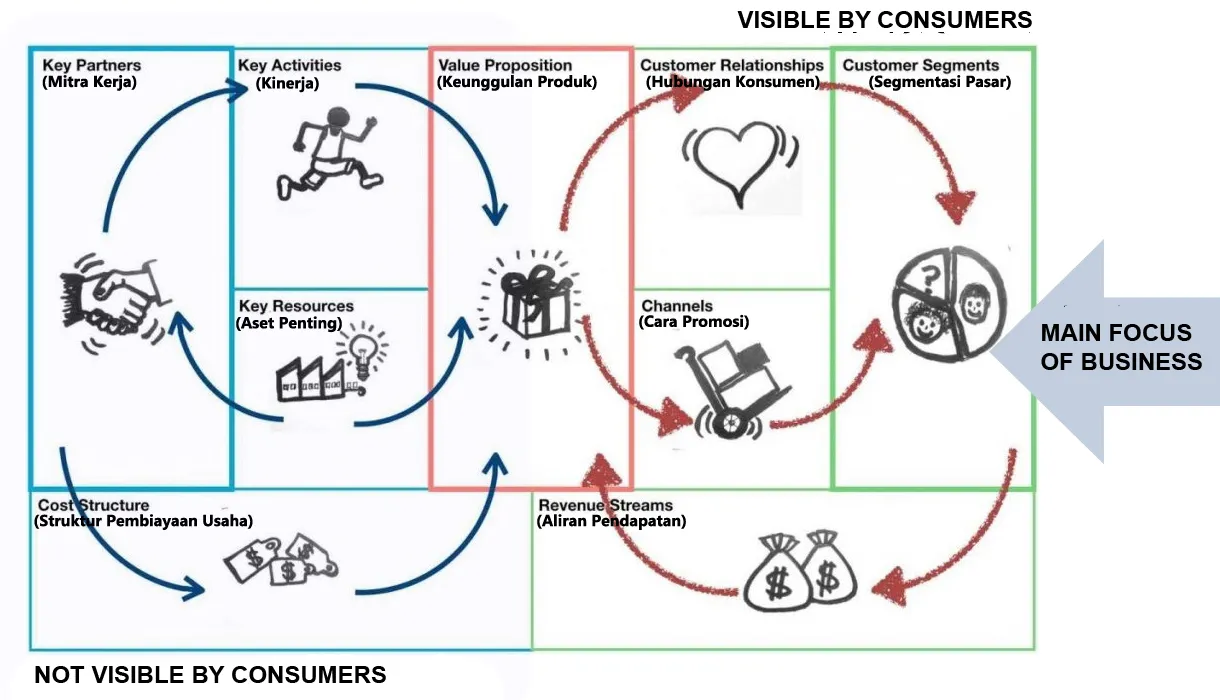The Business Model Canvas (BMC) is a strategic management tool used to prepare all business requirements quickly, easily define and communicate the business idea or concept you want to run. The concept of the Business Model Canvas is a form of initial framework that is useful in terms of explaining a business idea.
A business can be developed into a startup. The term startup is often associated with businesses or businesses that have just started or businesses that are just developing. According to Steve Blank, a startup is an organization formed to find a repeatable and scalable business model. Meanwhile, according to Eric Reis, startups are rules or norms designed by humans to deliver new products or services in uncertainty.
The key to starting a business or creating a startup is having the ability to grow. Because a startup is a company that is designed to continue to grow rapidly. The growth of startups is not limited geographically, which is different from small businesses. In the growth and development of startups, the internet is an important factor.
However, developing a business in the form of a startup is more challenging than imagined, and many startups fail to develop. Some of the failures of growing a business by forming a startup, including the following.
- Lack of knowledge and understanding of business models that can assist in business development.
- Financial problems, which can be in the form of capital or a lack of ability to determine the selling price, making it difficult to compete with other similar products at prices that are more affordable by the market.
- Development of products or services that are less innovative and creative, so that they cannot highlight the superiority or uniqueness of the products or services offered. This can have an impact on business development that is very slow or even unable to develop at all.
- Mistakes in carrying out trading strategies. This is very fatal for businesses that have just started or are just developing. Therefore, an entrepreneur must have foresight and sensitivity in seeing market share. For example, there is a change in consumer habits in buying a product or service before the existence of the internet with after the internet. As can be seen from the chart below.
Consumer Shopping Habits Before the Digital Era
Consumer Shopping Habits After the Digital Era
Suppose an entrepreneur cannot anticipate changes in consumer spending habits in the process of trading his products. In that case, the development of his business will be prolonged and will even be abandoned by consumers.
One solution that can be taken to prevent failure in developing a new business or startup is to use the Business Model Canvas (BMC) combined with the SWOT analysis that we have discussed in the previous sub-chapter. The Business Model Canvas (BMC) is a business model that provides a detailed and logical description of how to start a new business or business. The Business Model Canvas (BMC) was developed by Alexander Osterwalder and Yves Pigneur (1990).
Why Business Model Canvas (BMC) ?
An explanation of why a startup business must take the BMC model is as follows:
- BMC is presented in a visual form, such as a painting canvas so that it can be known and understood more easily.
- BMC as “material” to explain, assess, and change a business model, so that it is able to innovate or excel in competition.
- BMC can be used for business scale in all business fields.
- BMC is very helpful in speeding up the process of analyzing business strengths and weaknesses (analysis of needs and profits can be done quickly).
- BMC is prepared by involving all levels of management in the company’s business development.
The Business Model Canvas consists of 9 main components, which are: Customer Segment, Customer Relationship, Customer Channel, Revenue Structure, Value Proposition, Key Activities, Key Resource, Cost Structure, dan Key Partners.
Nine Components of the Business Model Canvas (BMC)
The nine components of BMC will be explained one by one, which are.
- Customer Segment (Market Segmentation)
At BMC entrepreneurs are required to determine market segmentation in detail to get a definite picture of which consumers will be targeted as users of the goods or services offered.
- Customer Relationship (Relationship Or Engagement With Consumers)
This component aims to form bonds with consumers, both new customers or customers, and old customers or consumers. In addition to forming bonds, this component also serves to introduce and offer new products and services to new and existing customers or consumers. For example, discounts, promo codes, member cards, etc.
- Customer Channel (Promotion Method)
Customer Channels are ways to promote the goods or services offered to convey the superiority or uniqueness of the product. Thus consumers are interested in buying or using it based on the consumer assessment. For example, food testers, clothing displays and others.
Other Customers Channel functions include the following.
-
- Introducing consumers so that consumers are aware of the products or services offered.
- Helping consumers to assess the uniqueness or superiority of products or services.
- Facilitate customers to buy products or services.
- Provide post-sales support.
- Value Proposition (Product Advantages or Uniqueness)
The superiority or uniqueness of the product determines why the product we offer deserves to be chosen by consumers, besides that the superiority or uniqueness of the product must stand out from competitors and fulfill consumer desires. Some aspects that can be superior, namely, price, brand, design, price discounts, service if there is damage, and others.
- Revenue Structure/ Revenue Stream
Income stream or inflow of funds, namely how to get income from the customer segment, both in the form of transactional income (direct buying and selling) and repetition (repeat orders). In addition, incoming funds can also be obtained from sales of products resulting from the development of existing products or from business fields related to the business sector being developed. For example, Padang restaurants sell rendang in cans, sell various merchandise, and so on.
- Key Activities
Key Activities are actions that can determine the course of a business or business. This component plays an important role in highlighting the superiority or uniqueness of the product. Types of key activities, which are.
-
- Production operation
- Service operation (service)
- Platforms and networks
- Key Resources
These are important assets owned by the company. These assets include, human resources (HR), physical resources such as buildings and equipment, money, and intellectual assets (brands, patents, copyrights, customer databases, etc. Key Resources must support the value propositions of products offered, channels, customer relationships, and revenue streams.
- Key Partners
Key Partners are a colleague who can be invited to cooperate in business development. The purpose of having cooperation partners is to optimize budget savings, reduce risks from unexpected things, and take over resources and activities, so that business management is more effective.
- Cost Structure (Business Financing Structure)
Describe all costs incurred for running the business. Financial management is very important, because if money management is not sound, business development will be slow or not develop at all. Types of cost structure, namely, Cost driven (capital), Value driven (reserve costs), fixed costs, and variable costs.
Fixed costs are costs that are fixed, not affected by the size of production. For example, land rent, building rent, equipment/building depreciation, labor wages, and others
Variable Costs are costs that change in nature, influenced by the size of production. For example, plant seeds, raw materials, fertilizers, pesticides, and external/seasonal labor wages.
Main Components in the Business Model Canvas (BMC)
Based on the picture above, it can be seen that the main focus in developing a business using BMC is customer segments, customer relationships, revenue streams, channels, value propositions. At the same time, other components must be able to support the main components that consumers can see directly.
Keep in mind that the Business Model Canvas is not a recipe to be followed rigidly, but only an overview of starting a business or developing a new business. So the evaluation of the BMC that has been made is very important and adapted to the current developments. In addition, evaluation is needed to face challenges from competitors, dare to innovate, and have different advantages from competitors.



















